Knowing how to water bonsai a tree is essential to preserve these tiny treasures of nature’s art. Due to their small pots that hold limited water and nutrients, understanding watering bonsai trees is crucial for their well-being.
Bonsai trees aren’t your average houseplants. The specifics of watering them, from the timing to the technique, are influenced by numerous elements, including the prevention of root rot. We’ll delve into these factors in this post.
By grasping these elements, you’ll be making strides toward mastering the crucial skill of tending to your bonsai’s hydration needs.
Specifically, we’ll discuss:
- The Basics of Watering Bonsai Trees
- Bonsai Watering Techniques
- Addressing Common Bonsai Watering Issues
Understanding the Basics of Watering Bonsai Trees

Just as with any other plant or tree, hydration plays a key role in the care of bonsai trees, directly influencing their health and vibrancy. To promote the growth of your bonsai, it’s crucial to grasp the watering basics.
This includes understanding the factors that dictate the watering frequency for your bonsai and discovering the perfect harmony between giving ample water and facilitating appropriate drainage.
Frequency and Timing of Watering
Before we explore the specifics of when and how to water a bonsai tree, it’s vital to understand what influences their watering schedule.
The frequency with which you should quench your bonsai’s thirst during the day or week hinges on the following considerations:
Soil Quality
The quality of the soil used for your bonsai affects how often they need to be watered.
Incorporating robust elements into your bonsai soil blend, such as Akadama, pine bark, and lava rock, aids in forming soil that drains effectively. Conversely, integrating moisture-preserving components like peat moss or rice hull can ensure the soil retains an adequate level of dampness.
If the soil your bonsai is planted in has quick-draining properties, you’ll find yourself watering it more frequently. Conversely, if the soil retains moisture for extended periods, the need to water your bonsai will be less frequent.
Species of Your Bonsai Tree
The hydration schedule for your bonsai tree is guided by its particular species, as each type has unique hydration necessities. Some may thrive with abundant moisture, while others flourish when their environment is notably dry.
You can check out some bonsai tree species and their water preference here.
Size and Drainage of the Bonsai Pot
The size and drainage of the pot is also an essential factor. Bonsai trees nestled in petite pots call for more regular hydration due to their restricted capacity for water storage. In contrast, bonsai trees residing in more spacious pots demand less frequent watering since they possess a greater water-holding capacity.
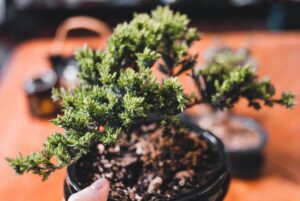
When considering pot drainage, a pot equipped with large drainage openings allows the soil to lose moisture more rapidly as it doesn’t retain surplus water. Thus, the need for watering becomes more frequent.
Wind, Humidity, and Temperature in the Area
Another significant determinant that profoundly influences how often you need to water your bonsai trees is the temperature of the environment. As your tree loses water through transpiration, the faster it dries out, so the more frequently you’d have to water it.
Seasons
The watering requirements of your bonsai tree can change significantly with the seasons. As weather patterns shift throughout the year, so does the watering frequency for your bonsai trees.
There are intervals that call for more regular hydration and moments when the watering can be dialed back. Grasping these seasonal shifts is essential in preserving the health and vigor of your bonsai tree.
Below is detailed information on how each season impacts the watering of your bonsai tree.
In Spring and Summer
During this phase, your bonsai tree’s thirst escalates as it fuels fresh growth. To keep it from becoming parched, here are some strategies you can employ to help the soil hold onto more water:
- Protect your tree from the hot weather and direct sunlight by placing a shade cloth above the tree.
- Find a spot with afternoon shade for your bonsai.
- Gently lay a thin veil of sphagnum moss atop your bonsai’s soil.
During the balmy summer months, it’s crucial to keep an artistic yet practical eye on your bonsai daily. This is to make sure it doesn’t fall victim to complete dehydration.
In fall and Winter
Most deciduous trees drop their leaves during the fall season. When this happens, you’ll need to water your bonsai less frequently.
As winter sets in, numerous types of trees enter a dormant state, leading to a decrease in their water absorption. This likely means you’ll be hydrating your bonsai less frequently compared to the past seasons.
If your bonsai is beautifully cloaked in a blanket of snow, its watering needs may be minimal or even non-existent. However, it’s still crucial to maintain a daily routine of inspecting your trees throughout the frosty season, ensuring they’re not suffering from insufficient hydration.
Best Time to Water Bonsai Trees
If you came here to find a set schedule on when to water bonsai trees, I’m sorry to disappoint you, but you won’t see any of that here.
That’s because bonsai trees are only supposed to be watered when they need it.
Watering bonsai trees in routine could cause either:
- Root rot due to overwatering
- Dry, dead roots due to underwatering
As a rule of thumb, water your bonsai once its soil gets slightly dry.
Check the soil moisture in the morning, and water it as necessary. You may repeat the same process in the late afternoon or early evening during hotter days.
Watering miniature trees in the afternoon is not encouraged unless very dry. That’s because the tree will only lose its water due to increased transpiration.
However, when you do, make sure not to use cold water in watering your outdoor bonsai. Otherwise, your tree will get shocked by a sudden temperature change.
Monitoring Soil Moisture Levels
Though hydrating your bonsai is essential, it’s usually not advisable to water it daily unless the soil is notably parched. A practical method to gauge if your tree needs a drink is by monitoring the soil’s moisture content.
By doing so, you can guarantee your bonsai gets the precise level of hydration necessary for its flourishing growth. Here are a few varied approaches you can employ to achieve this:
#1 — Use a Soil Moisture Meter
For a precise assessment of moisture, consider using a soil moisture meter. This beneficial tool can be easily found in gardening shops and general retail outlets. Moreover, it’s a breeze to set up.
#2 — Perform the Chopstick Method
In the absence of a soil moisture meter, an untreated wooden chopstick can serve as a practical substitute.
#3 — Assess the Color of the Soil
You can easily check if your bonsai tree needs watering without using any device. Just take a look at the soil surface and its color.
When the soil sports a dark hue, it’s an indication that it remains moist and does not require further watering. However, if the color appears lighter, it’s a definitive signal that your bonsai is parched and would benefit from a refreshing drink of water.
When there’s moss covering the soil, gently remove a small part to get a better look at the soil color.
#4 — Do the Finger Method
Another way to check the moisture of the soil is by using your finger. The best part is, it doesn’t cost a thing!
However, it might take some practice to accurately determine if the soil is dry or wet, especially in colder seasons when the soil feels cold to touch.
In this case, simply dip your finger at least an inch deep into the soil and feel its temperature to assess its moisture level.
#5 — Weigh the Whole Tree by Hand
For those who’d rather keep their hands spotless, there’s an alternative approach to gauge the moisture level of your bonsai tree. Instead of evaluating the soil’s color or dampness, consider lifting the entire tree to estimate its level of hydration.
This method requires some experience to get accurate results and works best for smaller bonsai trees, as larger specimens may be difficult and inconvenient to carry.

Typically, moist soil feels heavier than dry soil. If you notice that your tree feels lighter in your hand, it’s a sign that it needs a thorough watering session.
Importance of Proper Drainage
Understanding how to water a bonsai tree effectively involves not just knowing when to water but also ensuring proper drainage. Examine the base of your bonsai pot and inspect for poor soil drainage or openings. If they’re absent, it might be necessary to introduce a few.
Having drainage holes allows water to be poured onto the soil surface and flow out through the bottom of the pot. This process is essential as it ensures that only a portion of the water is retained by the roots while the excess drains away.
Know the Best Water for Your Bonsai
Understanding the ideal watering schedule for bonsai is crucial, but the type of water used is equally important. Rainwater reigns supreme for its chemical-free purity, unlike tap water, which may contain harmful elements like calcium.
Filtered water emerges as a beneficial alternative, eliminating impurities and promoting robust growth. Mineral water, despite its allure, offers minimal benefits and may introduce plastic contaminants. Distilled water, while neutral, lacks essential minerals, potentially impacting bonsai health negatively. Ultimately, opting for rain or filtered water ensures optimal bonsai vitality and growth.
While there are acid-loving trees like Azaleas, most bonsai tree species can be watered with tap water.
However, if you want the best and safest water for your bonsai trees, just use collected rainwater!
Impact of Water pH Levels on Bonsai Health
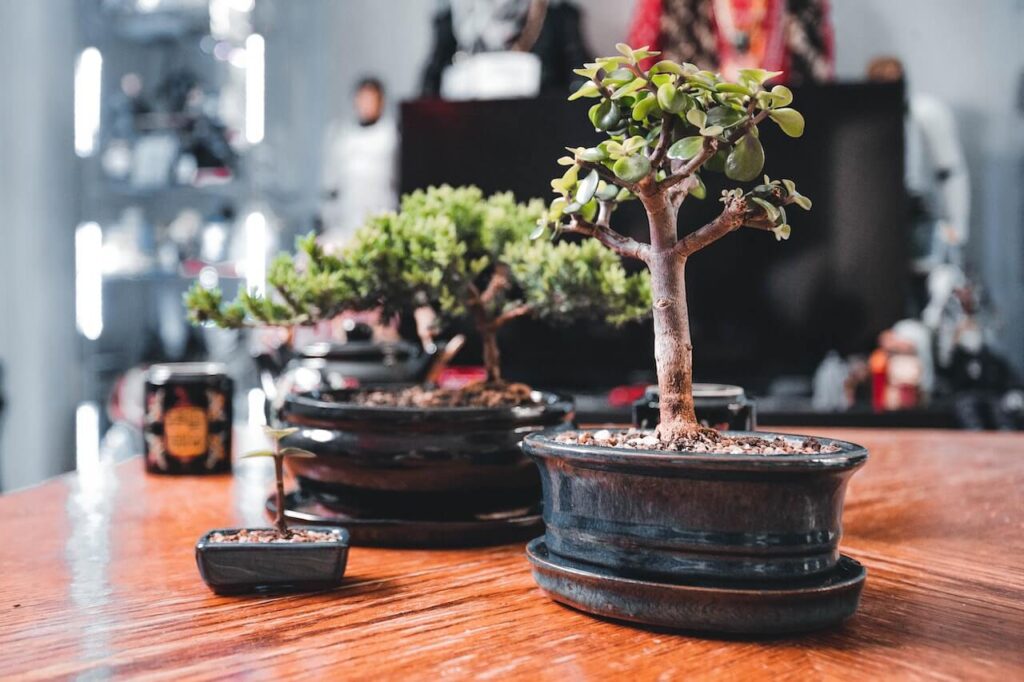
Water quality is something that is overlooked in many many bonsai collections around the world. Despite the common belief that water fit for human drinking is good enough for hydrating bonsai, it can actually have negative consequences.
When the water has a higher pH, it can reduce nutrient absorption, hinder root growth, and lead to deficiencies in essential elements like magnesium.
Moreover, alkaline water may result in limescale buildup, potentially blocking leaf stomata and affecting the tree’s ability to produce food.
Bonsai Watering Techniques
Now that you’ve learned about the different types of water, let’s explore how to water a bonsai tree effectively by discussing the various methods you can employ.
Manual Watering and Misting
Hand-watering your bonsai trees is the most effective technique you can employ. It gives you absolute control over the volume of water and the pressure applied, ensuring your delicate bonsai gets just what it needs.
Step-by-step guide on manual watering of miniature trees:
- Grab your watering can or wand.
- Water the bonsai tree from the top.
- Continue watering until you see the water runs out from the pot drainage holes.
- Move on to your next tree, or wait for a few minutes until the pot drains.
- Then, repeat steps 2 to 3.
Suppose the water starts pilling on top of the soil surface. Stop watering for a few seconds or minutes until the soil soaks the water in. Then, continue watering your tree properly.
Important note: Piling water on top of the soil surface can mean that your soil has already become compact. If that’s the case, you’d have to repot your tree in the coming spring.
Also, don’t forget to occasionally mist the foliage with a gentle water mister or spray bottle. Not only does this practice clear away leaf dust, but it also boosts the humidity surrounding your bonsai.
Immersion
If your bonsai tree is completely dried out for days, you can water your bonsai tree by dunking its whole pot into the water. This method helps ensure that no part of the soil is left unwatered.
Tip: This method only applies to smaller bonsai trees that can be conveniently carried around.
Automated Watering
If you’re going out for a few days or weeks, installing an automated watering system for your bonsai trees can provide you with convenience and peace of mind.
It allows you to remotely water your trees at scheduled times and even adjust them during rainfall to prevent overwatering.
However, it’s important to note that for longer durations, the devices may become less reliable, so periodic checks are necessary to ensure proper functionality, especially for larger bonsai collections.
Bonsai Watering Tools
There are two basic watering tools you can use for your bonsai trees: a watering can with a fine nozzle and a watering wand attached to a gardening hose.
- Watering Can with a Fine Nozzle. This tool allows you to mix in liquid fertilizer and is convenient for watering indoor bonsai trees due to its portability.
- Watering Wand attached to a Gardening Hose. Although not as flexible as watering cans, this watering tool is effective for watering your bonsai trees.
Remember to consider the specific needs of your bonsai species and other factors we discussed when selecting the best quality watering method.
Watering Bonsai Trees Based on Specific Circumstances
Understanding how to water a bonsai tree based on specific circumstances is crucial for its health and growth. Let’s delve into the nuances of watering during different stages of bonsai growth, as well as when repotting or pruning.
Watering during Different Stages of Bonsai Growth
Apart from their species, your tree’s growth stage also influences how often you should water your bonsai. Young and developing trees, as well as those in the growing season, require frequent watering. On the other hand, dormant trees need less water.
Watering when Repotting or Pruning
After repotting your bonsai tree, it’s crucial to give it proper care for a successful transition. Watering immediately after repotting helps moisten the roots and settle the soil, so be generous with watering to saturate the new soil.
Watering during Times of Stress or Disease
When trying to revive a sick bonsai, don’t be tempted to overwater as it can further harm the tree. Instead, closely monitor your tree’s soil moisture on a daily basis and water it thoroughly once the soil becomes slightly dry.
The frequency of watering will depend on the tree’s condition, ranging from a few times a week to longer intervals.
Taking a careful and observant approach will help support the tree’s recovery without risking over watering.
Addressing Common Bonsai Watering Issues
Keeping your bonsai tree properly hydrated requires a delicate balance. Over watering can lead to root related problems, while under watering can cause the tree to become dry and wilted.
Determining the perfect quantity of water for your bonsai is a meticulous and exacting task.
Overwatering
Watering your bonsai is essential, but be aware that overwatering can spell disaster. Stay vigilant for indications of too much water, like yellowing or falling leaves, withering branches, and stem dieback. Your bonsai’s health depends on your watchful care.
When a live portion of the bonsai root ball becomes smaller, it will no longer be able to support the trunk and primary branches, which may cause the bonsai plant to die. This could be a sign of root rot.
To address these issues, remove the tree from its pot, check for decayed roots, retain healthy ones, and trim any yellowing leaves. Thoroughly rinse the tree, repot it in the fresh soil mixture, and treat fungal infections or kill root rotting bacteria with chamomile tea or powdered cinnamon.
Remember to position the bonsai in a well-lit area with indirect sunlight and water moderately as the soil dries out.
Underwatering
Your bonsai tree, like any other plant, needs moisture at its root system to thrive. Lack of continuous moisture can lead to leaf loss, branch withering, and ultimately your bonsai tree may die.
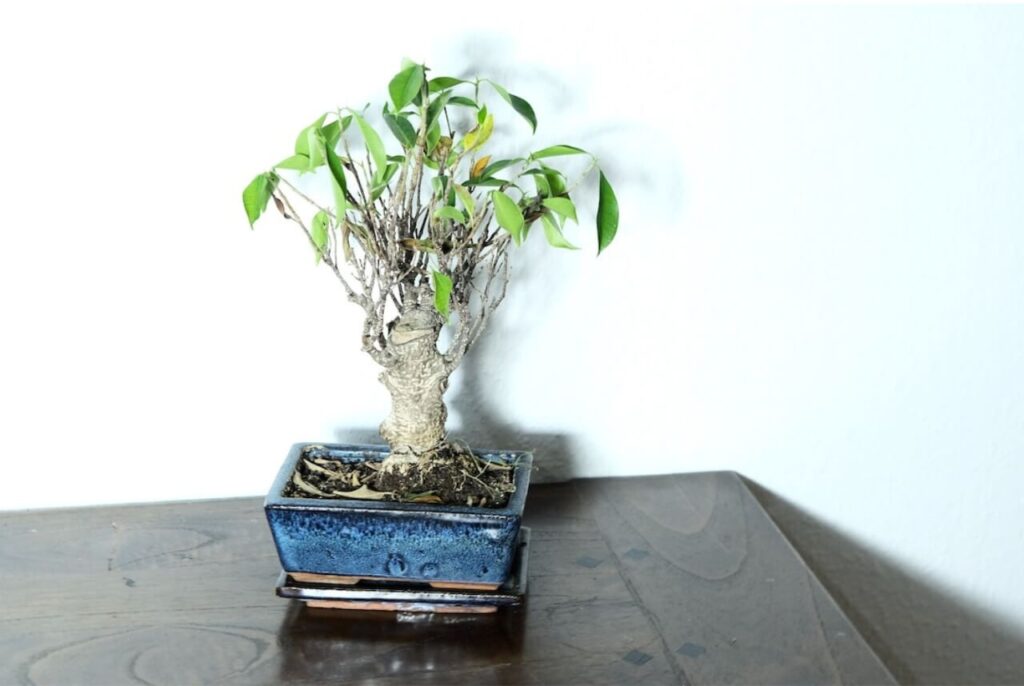
To prevent underwatering, never let the soil compost completely dry out. Watch out for symptoms such as yellowing or drying leaves, browning leaves, and dry soil.
When this happens, quickly address the issue by immersing or “dunking” your bonsai tree in water. Delayed action may result in irreversible damage to the branches, trunk, and roots, making it difficult for the bonsai to recover.
Maintaining Essential Humidity around the Bonsai Tree
Just like normal trees, bonsai should also be placed outdoors, where they are exposed to the four natural seasons.
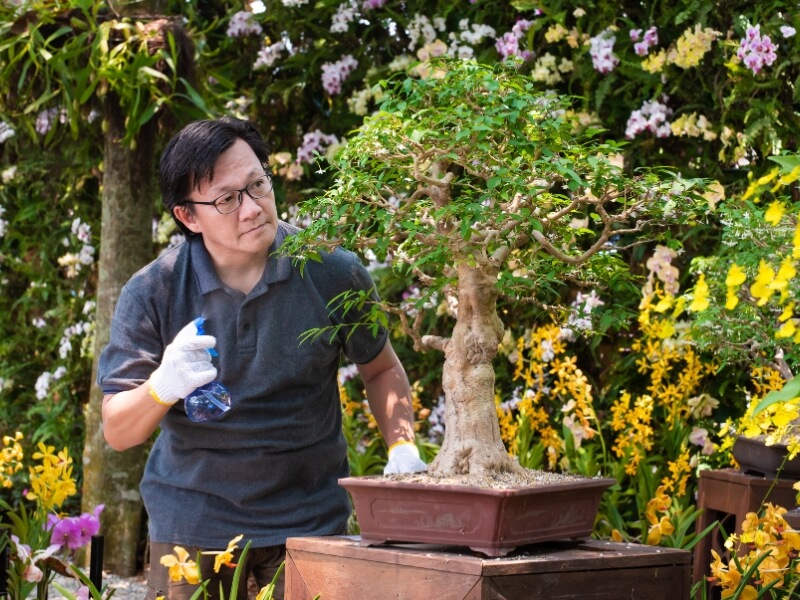
Leaving your bonsai tree indoors can negatively affect its leaves, as the air inside is very dry. To counteract this, mist the leaves regularly throughout the day, and avoid placing your bonsai near vents or drafts, as they can dry out the foliage.
Another effective method to increase local humidity is by using pebble humidity trays.
Dealing with Mineral Buildup in Soil or Pots
Have you noticed those thin or thick white crusts on the inside lip, outside lip, or wider body of a pot? Those white crusts are caused by a build-up of calcium carbonate particles from tap water.
To sidestep these complications, it’s wise to use rainwater or filtered water with minimal calcium levels. If you’re already contending with white crusts, rest easy, there are a number of effective techniques for their removal.
You can use a toothbrush or bonsai brush with water, vinegar, or descaler, or gently scrape them off by hand for antique pots.
Conclusion: Keep Your Bonsai Properly Watered
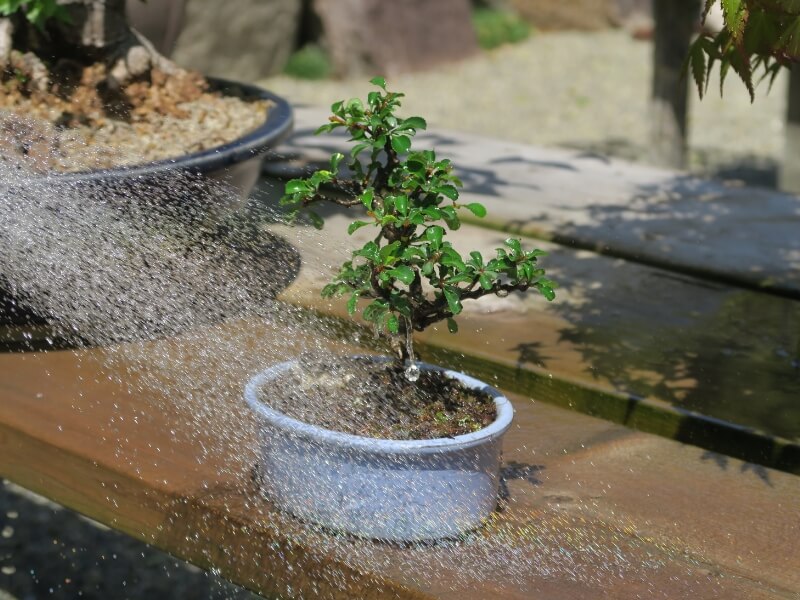
Proper watering is a critical aspect of bonsai care. Knowing how to water a bonsai tree and understanding the unique watering needs of your bonsai is essential for its health and vitality and to prevent issues like root rot. By using appropriate watering techniques and addressing bonsai watering issues, you can ensure that your bonsai lives for years to come.
For more valuable tips and detailed information on bonsai care, make sure to visit our blog. It has everything you need to ensure your bonsai keeps thriving and bringing happiness.


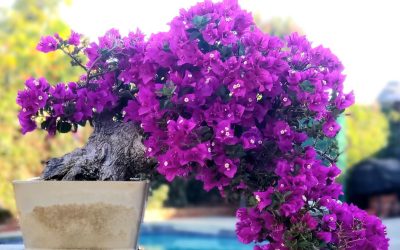
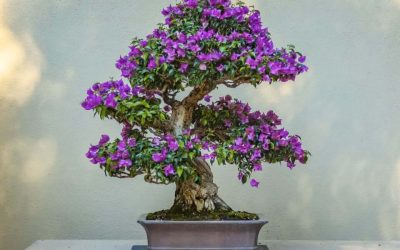
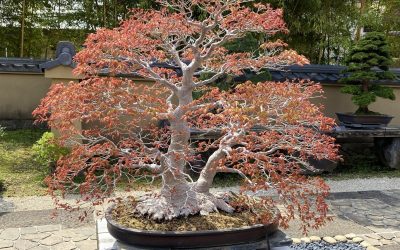
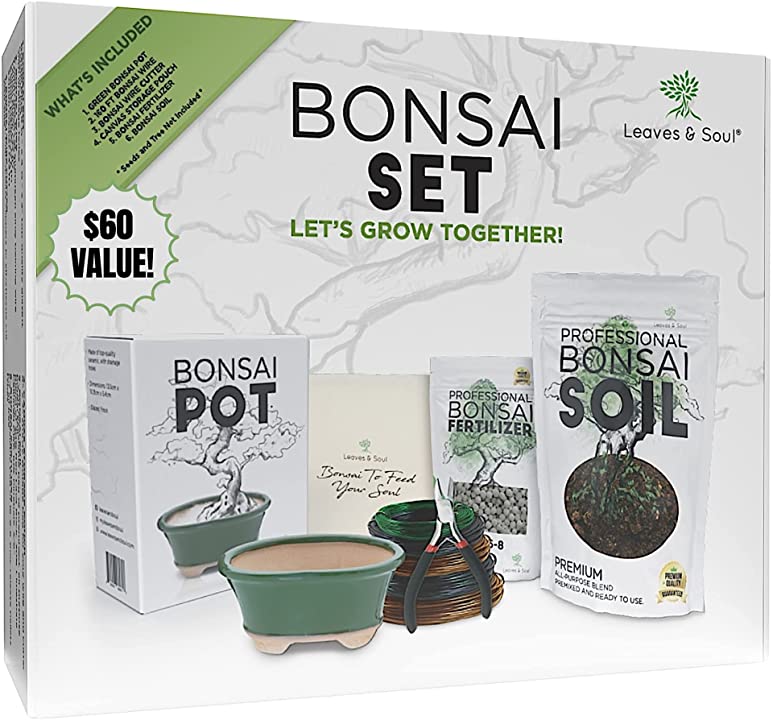
0 Comments